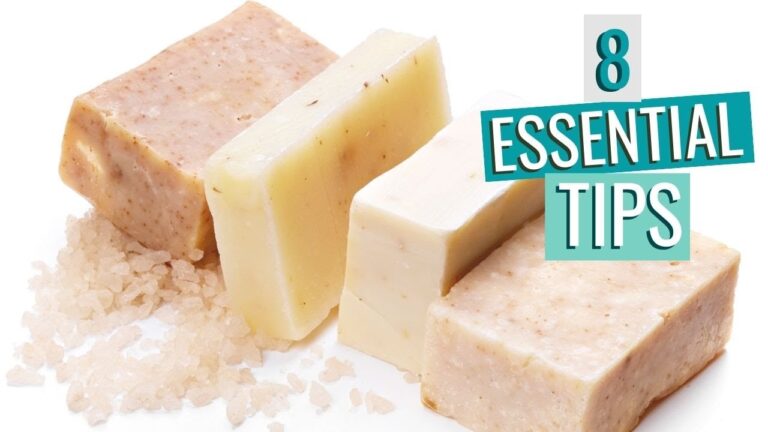Are you tired of using store-bought soaps that leave your skin feeling dry and irritated? Look no further! Curing handmade soap is the solution to your skincare woes. This age-old process not only enhances the quality and longevity of the soap, but also allows for a more luxurious and moisturizing lather. In this article, we will delve into the art of curing handmade soap and explore the benefits it brings to your daily skincare routine. Say goodbye to harsh chemicals and hello to naturally nourished skin with cured handmade soap.
How long does it take for handmade soap to cure?
Handmade soap typically takes about 4-6 weeks to cure fully. During this time, the soap undergoes a process called saponification, where the oils and lye react to create soap. This curing period allows the soap to harden and the excess moisture to evaporate, resulting in a harder, longer-lasting bar with a better lather.
The curing time can vary depending on factors such as the recipe used, the amount of water in the soap, and the ambient temperature and humidity. Some soapmakers may choose to cure their soap for longer periods to ensure a milder and longer-lasting bar. It’s important to be patient and allow your handmade soap to cure properly to achieve the best results.
Why is curing handmade soap important?
Curing handmade soap is important because it allows the soap to become milder and longer lasting. During the curing process, excess water evaporates from the soap, resulting in a harder, longer lasting bar. This makes the soap more economical and reduces waste, as it won’t dissolve as quickly in the shower or at the sink.
Additionally, curing handmade soap also allows the soap to become milder on the skin. As the soap cures, the pH levels stabilize, making it gentler and less likely to cause irritation or dryness. This is especially important for people with sensitive skin or skin conditions, as well as for those who prefer natural, chemical-free products.
Overall, curing handmade soap is important because it enhances the quality and performance of the soap, making it a more sustainable and skin-friendly option. By allowing the soap to cure, it becomes a longer lasting, milder product that benefits both the user and the environment.
What are the best methods for curing handmade soap?
When it comes to curing handmade soap, there are a few key methods that can help ensure a high-quality final product. One effective method is allowing the soap to cure for an adequate amount of time, typically around 4-6 weeks. During this time, the soap will continue to harden and dry out, resulting in a longer-lasting bar with a better lather. Another important method is properly storing the soap during the curing process. It’s essential to keep the soap in a cool, dry place away from direct sunlight and humidity to prevent it from sweating or losing its scent.
Additionally, rotating the soap during the curing process can help ensure even drying and distribution of moisture throughout the bar. This can be done by flipping the soap over every few days to allow all sides to dry evenly. It’s also important to monitor the soap regularly during the curing process to ensure it is progressing as expected. By following these methods, you can create handmade soap that is not only beautiful and fragrant but also long-lasting and effective for your skin.
In conclusion, curing handmade soap is a delicate process that requires patience and attention to detail. By allowing the soap to cure for the proper amount of time, storing it correctly, and rotating it regularly, you can ensure a high-quality final product that will be a joy to use. With these methods in mind, you can create handmade soap that is not only visually appealing but also nourishing and beneficial for your skin.
Master the Art of Soapmaking
Discover the art of soap making and elevate your self-care routine with our comprehensive guide. Whether you’re a beginner or an experienced crafter, our step-by-step instructions and expert tips will help you create luxurious, custom soaps that cater to your skin’s specific needs. From choosing the perfect ingredients to mastering intricate designs, unleash your creativity and indulge in the satisfaction of crafting your own signature soaps. Dive into the world of soap making and unlock a new level of pampering that’s both rewarding and nourishing for your skin.
Crafting Luxurious Handmade Soaps
Indulge in the art of pampering with our luxurious handmade soaps, meticulously crafted to elevate your bathing experience. Each bar is lovingly made with premium ingredients like shea butter, coconut oil, and essential oils to nourish your skin and awaken your senses. Our handmade soaps are not only a treat for your skin, but also a feast for your eyes with their beautiful designs and captivating scents.
Experience the difference with our artisanal soaps, handcrafted in small batches to ensure quality and attention to detail. From soothing lavender to invigorating citrus, our collection offers a variety of scents to suit every mood and preference. Treat yourself to a moment of relaxation and self-care as you lather up with our luxurious handmade soaps, leaving your skin feeling soft, smooth, and rejuvenated.
Elevate your daily routine with our exquisite handmade soaps, a decadent indulgence that transforms your ordinary shower into a spa-like experience. Our commitment to using only the finest ingredients results in a product that not only cleanses and moisturizes, but also delights the senses. Treat yourself or someone special to the gift of luxury with our handmade soaps, because you deserve a little bit of pampering every day.
A Beginner’s Guide to Creating Natural Soaps
If you’re new to soap-making, creating natural soaps can be a fun and rewarding hobby. To start, gather high-quality oils and butters, such as coconut oil and shea butter, and essential oils for fragrance. Follow a simple recipe and use lye carefully, making sure to wear protective gear and work in a well-ventilated area. Experiment with different textures, colors, and scents to create your own unique natural soaps. With a little practice, you’ll soon be crafting beautiful, nourishing soaps that are perfect for gifting or pampering yourself.
With its natural ingredients and unique handcrafted process, curing handmade soap not only enhances its quality and longevity but also allows for a luxurious and indulgent bathing experience. By taking the time to properly cure your handmade soap, you can ensure a superior product that nourishes and pampers your skin, making it a truly special addition to your self-care routine. Experience the difference of cured handmade soap and elevate your daily cleansing ritual to a luxurious and rejuvenating experience.



